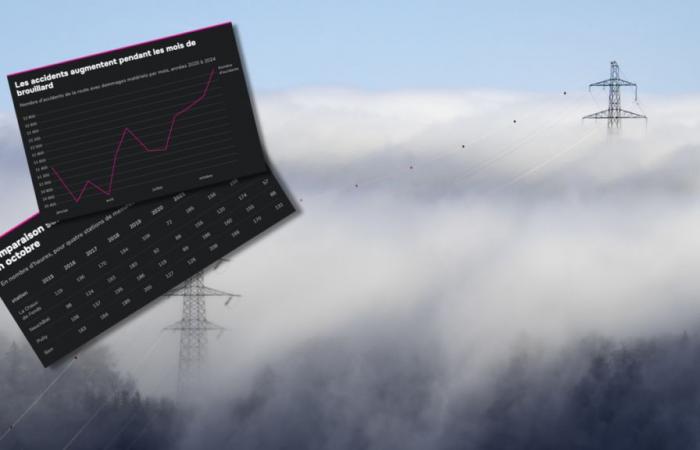Two different worlds: Gray below and sunny and colorful above – like here with the view of the sea of fog and the Wetterhorn, Schreckhorn, Eiger, Mönch and Jungfrau.Image: keystone
Fog covered Switzerland for several days and people took refuge in the mountains. However, there should be fewer and fewer foggy days.
Bruno Knellwolf / ch media
The Swiss are on the run. At least last weekend, people from the plains flocked to the mountains to escape the punishing fog. And on the way back, they found themselves stuck on the roads in front of gray towns and villages.
This is not surprising, because in the plains, the sun has rarely shown itself in recent weeks. In October, Météo Suisse measured less sunshine in many places than at any time in the last ten years. At the Neuchâtel measuring station, there were only 57 hours of sunshine, three times fewer than in 2023 and, by far, the lowest total in the last ten years. Same observation in Pully (VD). There was also relatively little sunshine in Sion, Zurich, Bern or La Chaux-de-Fonds.
Fog can not only take a toll on our psyche, but it also reduces visibility in traffic, leading to an increase in the number of accidents. In addition, it has an influence on air quality. But how is it formed? And is it really in decline in Switzerland?
Why does the fog last so long?
Fog covered Switzerland for almost two weeks. Blame it on persistent anticyclonic conditions. Indeed, anticyclonic situations are a prerequisite for the appearance of stubborn fog during the autumn and winter months. When the anticyclonic situation is stable, cold air forms during the night. The heavier cold air then slowly flows close to the groundfrom the Alpine valleys and the Jura towards the Plateau. In addition, cold air also forms on site during clear nights on the Plateau, as heat spreads into space.
The conditions then reverse: cold at the bottom, hot at the top. Meteorologists speak of an “inversion layer.” As the sun is low and there is little energy available, the lake of cold air that has formed cannot be fully dissipated during the day. As a result, temperatures on the Plateau generally drop a little more from one day to the next.
“But because cold air can absorb less moisture than warm air, condensation occurs over time and thus fog formation.”
Stephan Bader, MeteoSwiss
When a pronounced inversion has formed, the stratification of the lower atmosphere is extremely stable, meaning fog remains. The temperature inversion layer can then only be swept away by stronger winds. These occur when disturbances pass, generally cold fronts. We must therefore hope that such winds arrive to see the sun again soon.
Four conditions for fog
1. Weak sunshine or low sun, as in the period from mid-October to the first half of February.
2. Little wind in the lower layers of the atmosphere: as in the case of an anticyclonic situation.
3. Few clouds: also in the event of an anticyclonic situation.
4. Cold, moist air must be able to accumulate in a pool.
Why is the fog rising
If the fog was initially low and directly in the villages, the fog limit has since risen. The reason is the wind current which has reigned since November 2. This kiss has indeed completely changed the situation.
“The stronger the wind, the higher the fog.”
Stephan Bader, MeteoSwiss
If the weather report reports a tendency to fog or a weak wind, the upper limit is generally between 900 and 1200 meters above sea level. In case of moderate wind, the upper limit rises to 1500 meters, and the fog then penetrates further and further into the Pre-Alps and Alpine valleys. The wind current mixes the air mass below the inversion. Which leads to a higher level of condensation. Once this level is reached, the water begins to condense and droplets form, which gives rise to fog higher up.
Before November 2, the situation was different in the absence of a wind: in fact, if an anticyclone is directly above the Alps or if the pressure distribution is flat, the upper limit stabilizes at an altitude of 800 to 900 meters. On the other hand, if southwest winds arise, the upper limit drops to 500 or 700 meters.
Often, in such a weather situation, the anticyclone breaks up and what is known as the passage of a front ensues. In meteorology, a front is a narrow boundary zone between different air masses. In the front area, relatively sharp changes in atmospheric pressure, temperature, humidity and wind are observed. The passage of the front therefore chases away the fog, which was not the case this time.
The number of foggy days is actually decreasing
Many people are surprised by the intensity and duration of the fog. In fact, between 1971 and 2020, foggy days became rarer not only in autumn, but also during the entire foggy period from September to February. At the Zurich-Kloten site, the average from 1971 to 1980 was more than 50 days per year. Between 2010 and 2020, there were twelve fewer days of fog, or an average of 38 days.
To explain the decrease in the frequency of fog, specialists cite different aspects: a report from Météo Suisse shows that fluctuations in the frequency of fog evolve in parallel with those of the weather situations which cause the fog.
“This suggests that fluctuating weather conditions are the main drivers of different fog conditions. They create the most important conditions for fog to form.”
Stephan Bader
These are high pressure, weak westward air flow, accumulation of cold air over the Plateau and sufficient humidity. According to the climatologist, we have not yet studied the question sufficiently to know whether the warming of the atmosphere had an influence.
But there are other factors that contribute to the reduction in fog. Experts also attribute the general reduction in fog to the improvement in air quality. The reduction in sulfur dioxide emissions, which mainly comes from the combustion of fuel oil, has notably contributed to the reduction in fog. Sulfur dioxide promotes the condensation of water vapor and therefore the formation of fog:
“But besides that, the drying out of the soil due to the urbanization of the landscape would also be responsible”
According to this thesis, the expansion of residential areas not only dries the soil, but also the air, making conditions more difficult for fog. Although this fall, the situation is now different.
How to behave in fog on the road
Visibility reduced by fog increases the risk of accidents in planes and on the road.
“The sudden appearance of fog causes many accidents and the worst pileups take place in foggy weather.”
Luca Genovese, accident researcher at insurer Axa.
The insurer Axa does not have precise figures on fog-related accidents. However, we see that there are more of them during the months concerned.
Federal Roads Office (FEDRO)
Fog creates a film of moisture on the asphalt, which reduces adhesion to the road surface. It is therefore important to keep a sufficient distance from the car in front and drive carefully. Correct lighting is also decisive, explains Luca Genovese from Axa. The front fog lights and rear fog lights must be on. But only if it’s really foggy. Otherwise, these lights must be turned off, as they disturb oncoming drivers.
It should also be taken into account that modern vehicles are equipped with an automatic light switching system. During the day, they drive with daytime running lights, not the more powerful low beam lights. If the automatic headlight sensor does not detect fog itself, the dipped headlights should be switched on manually.
The news in Switzerland is here
Show all articles






